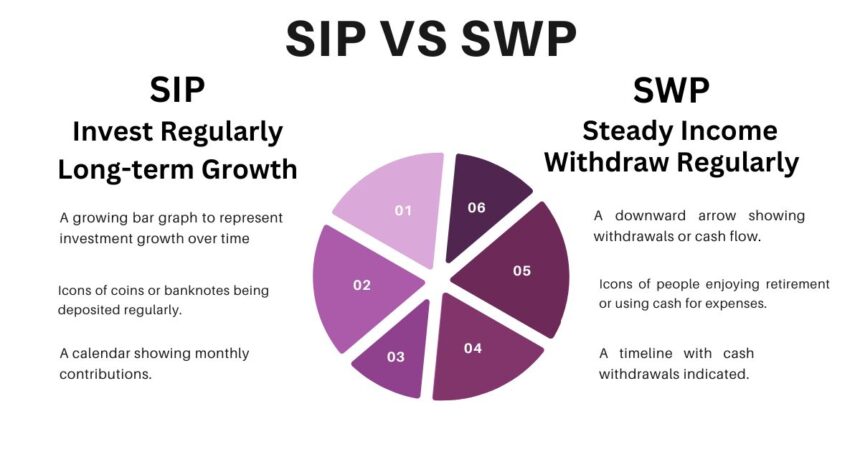In the world of investing, individuals often encounter various strategies to grow their wealth and secure their financial future. Two popular methods are the Systematic Investment Plan (SIP) and the Systematic Withdrawal Plan (SWP). This article delves into the nuances of SIP vs SWP, helping you determine which approach aligns with your financial objectives.
What is SIP?
A Systematic Investment Plan (SIP) is a disciplined approach to investing in mutual funds, allowing investors to contribute a fixed amount regularly, typically monthly. This method encourages saving and investment through small, manageable amounts rather than making a lump sum investment.
Benefits of SIP
- Rupee Cost Averaging: By investing a fixed amount regularly, SIPs enable investors to buy more units when prices are low and fewer units when prices are high, averaging out the cost over time.
- Disciplined Saving: SIP instills a habit of regular saving and investing, making it easier for individuals to build a substantial corpus over time.
- Flexibility: Investors can choose the amount and frequency of their contributions, making SIPs adaptable to various financial situations.
- Compounding Returns: The power of compounding works effectively in SIPs, where the returns generated on the investment can be reinvested to earn additional returns.
What is SWP?
On the other hand, a Systematic Withdrawal Plan (SWP) allows investors to withdraw a fixed amount from their mutual fund investment at regular intervals, typically monthly or quarterly. This strategy is commonly used by retirees or those seeking a steady income stream from their investments.
Benefits of SWP
- Regular Income: SWPs provide a predictable and regular income, making them ideal for retirees or those who need a constant cash flow for expenses.
- Flexibility in Withdrawals: Investors can customize the withdrawal amount and frequency based on their financial needs, making it a flexible option for managing cash flow.
- Capital Preservation: Withdrawing systematically helps preserve capital while still allowing the investment to grow over time, as not all funds are withdrawn at once.
- Tax Efficiency: SWPs can be more tax-efficient than lump-sum withdrawals, as they may allow investors to take advantage of lower capital gains tax brackets.
SIP vs SWP: Key Differences
Understanding the differences between SIP and SWP is crucial for making informed investment decisions. Here are some key distinctions:
| Feature | SIP | SWP |
|---|---|---|
| Purpose | Investment accumulation | Income generation |
| Investment Approach | Regular investments | Regular withdrawals |
| Cash Flow | No cash flow; focuses on growth | Provides regular cash flow |
| Ideal For | Long-term investors | Retirees or those needing income |
Which Strategy is Right for You?
The decision between SIP vs SWP largely depends on your financial goals, risk tolerance, and investment horizon. Here are some considerations to help you choose:
- Financial Goals: If your primary objective is to accumulate wealth for future goals (like buying a house or funding children’s education), SIP is the way to go. Conversely, if you require a steady income to meet monthly expenses, SWP is more suitable.
- Investment Horizon: SIPs are ideal for long-term investments, typically spanning five years or more. In contrast, SWPs are designed for individuals who need to withdraw funds regularly, making them more suitable for short to medium-term investment horizons.
- Risk Appetite: While both SIPs and SWPs involve mutual funds, SIPs are more appropriate for risk-tolerant investors looking for higher returns over time. SWPs may appeal more to risk-averse individuals seeking stability and income.
- Cash Flow Needs: Consider your cash flow requirements. If you have ongoing expenses or wish to fund a lifestyle without dipping into your savings entirely, SWP can help you maintain that balance.
The Role of Mutual Funds in SIP vs SWP
Both SIP and SWP primarily utilize mutual funds as the investment vehicle. Mutual funds pool money from various investors and allocate it across different asset classes, providing diversification and professional management.
- For SIP: Investors typically choose equity mutual funds for long-term growth potential. They can also consider hybrid or debt funds based on their risk tolerance and financial goals.
- For SWP: Many investors prefer balanced or debt mutual funds for SWP. As these provide stability and regular returns while minimizing the risk of significant capital erosion.
Tips for Implementing SIP vs SWP
-
SIP Implementation:
- Choose the right mutual fund based on your financial goals and risk profile.
- Set up automatic debits from your bank account to ensure consistency.
- Review your SIP performance periodically and adjust your investment strategy as needed.
-
SWP Implementation:
- Determine the withdrawal amount and frequency that aligns with your financial needs.
- Select a mutual fund that suits your risk tolerance and investment horizon.
- Keep an eye on market conditions and adjust your withdrawals if necessary.
Conclusion
When considering SIP vs SWP, it’s essential to align your investment strategy with your financial goals, risk appetite, and cash flow needs. SIP is ideal for accumulating wealth over the long term, while SWPs provide a reliable income stream for those who need it. Both strategies can complement each other, depending on your unique financial situation. By understanding the benefits and differences of SIP and SWP. You can make informed decisions that will help you achieve your financial objectives efficiently.



